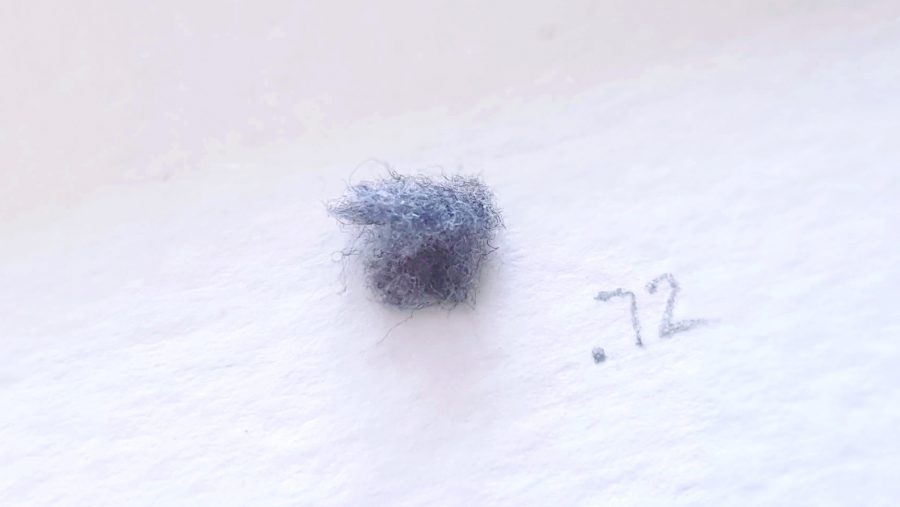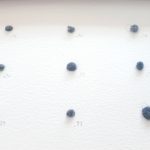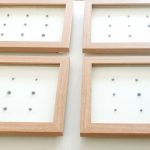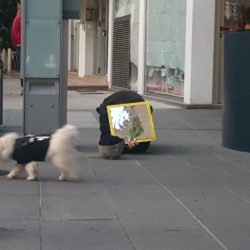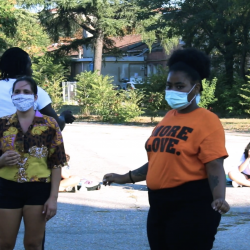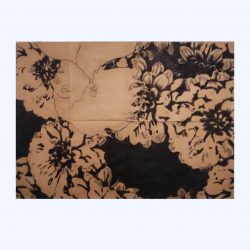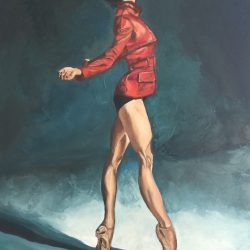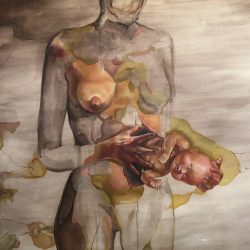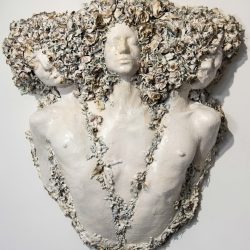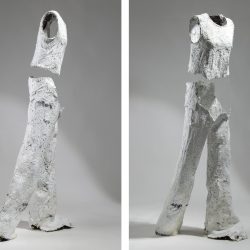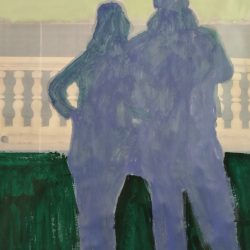work
On the Origin of the Species, 2020
| category | Other |
| subject | Human figure |
| tags | #cohabitation#nonhumans#insidehumans#lockdown |
| base | 16 cm |
| height | 21 cm |
| depth | 3 cm |
| year | 2020 |
'On the Origin of the Species, 2020' ('On the Origin of the Species'), was created during the first lockdown, following the pandemic triggered by the SARS-CoV-2 virus.
The subject of the work is a series of belly button fluffs/ lints, found in human navels, mainly in the navels of men. My interest in these objects is contextualized in the observation that every human being is viscerally linked and interdependent with what is not human; for instance oxygen, water, food, bacteria, without which we would not survive. 'On the Origin of the Species, 2020' highlights how ridiculous are human beings when they feel superior to what is non-human, considering that our own body presents and develops bacteria (non-human beings in our human body) which are vital to our own survival. The navel, that corresponds to the point of insertion of the umbilical cord, which, during intrauterine development, connects the fetus to the maternal body, guaranteeing the supply of oxygenated blood and nutrients, is the point where these lints are generated and in which bacteria proliferate. This aspect makes the humorous component of 'On the Origin of the Species, 2020' even more delineated, as it is precisely the indelible trace imprinted on our human body, represented by the navel, which reminds us of how much non-human presence there is in our human bodies, and consequently, how ridiculous is the violence and selfishness that mankind constantly imprints on the planet and everything that is not human- with consequences of injustice and violence that affect humans themselves.
In 'On the Origin of the Species' the fluffs found in a human navel are framed as a tangible demonstration of the human and non-human presence, and as something that we produce spontaneously. Scientific studies have shown that, despite the impressive diversity, the vast majority of the bacteria present in the tissue fluffs of human navels come from a few species. On the studies done, although there were no species common to each individual, eight species were present in at least 70% of the participants' fluffs. Together, those eight species accounted for nearly half of all bacteria found. The title, 'On the Origin of the Species', is a clear reference to the famous essay by Charles Darwin, 'On the Origin of the Species' ('On the Origin of the Species') published in 1859, and considered the foundation of evolutionary biology. 'On the Origin of the Species, 2020', however, refers to only one species, the human one, and is an irreverent way to praise yes, the importance of Charles Darwin's essay, but also to denounce the era of Anthropocentrism and today's human littleness, when humans believe to be the center of everything.
Medium: Belly button fluffs/lints (cotton fibres, bacteria- probably the same 8 type of bacteria in each fluff- stomach hair, sweat, house dust, flakes of skin), wooden frame, glass, cardboard.
The subject of the work is a series of belly button fluffs/ lints, found in human navels, mainly in the navels of men. My interest in these objects is contextualized in the observation that every human being is viscerally linked and interdependent with what is not human; for instance oxygen, water, food, bacteria, without which we would not survive. 'On the Origin of the Species, 2020' highlights how ridiculous are human beings when they feel superior to what is non-human, considering that our own body presents and develops bacteria (non-human beings in our human body) which are vital to our own survival. The navel, that corresponds to the point of insertion of the umbilical cord, which, during intrauterine development, connects the fetus to the maternal body, guaranteeing the supply of oxygenated blood and nutrients, is the point where these lints are generated and in which bacteria proliferate. This aspect makes the humorous component of 'On the Origin of the Species, 2020' even more delineated, as it is precisely the indelible trace imprinted on our human body, represented by the navel, which reminds us of how much non-human presence there is in our human bodies, and consequently, how ridiculous is the violence and selfishness that mankind constantly imprints on the planet and everything that is not human- with consequences of injustice and violence that affect humans themselves.
In 'On the Origin of the Species' the fluffs found in a human navel are framed as a tangible demonstration of the human and non-human presence, and as something that we produce spontaneously. Scientific studies have shown that, despite the impressive diversity, the vast majority of the bacteria present in the tissue fluffs of human navels come from a few species. On the studies done, although there were no species common to each individual, eight species were present in at least 70% of the participants' fluffs. Together, those eight species accounted for nearly half of all bacteria found. The title, 'On the Origin of the Species', is a clear reference to the famous essay by Charles Darwin, 'On the Origin of the Species' ('On the Origin of the Species') published in 1859, and considered the foundation of evolutionary biology. 'On the Origin of the Species, 2020', however, refers to only one species, the human one, and is an irreverent way to praise yes, the importance of Charles Darwin's essay, but also to denounce the era of Anthropocentrism and today's human littleness, when humans believe to be the center of everything.
Medium: Belly button fluffs/lints (cotton fibres, bacteria- probably the same 8 type of bacteria in each fluff- stomach hair, sweat, house dust, flakes of skin), wooden frame, glass, cardboard.



